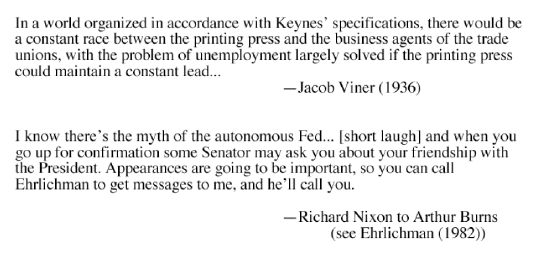 |
April 6, 2007 (Linda Stern - Boston Globe)
What's more frightening inflation or recession?
The answer, of course, is both. Accelerating prices and a slow- or no-growth economy is a killer combo that's been called "stagflation" since the 1960s.
Folks of a certain age might remember the stagflation which dominated the US economy in the 1970s. It was a gloomy time when energy prices (and gasoline lines) dominated the news; when whole industries slumped at the same time, and when job losses and price hikes seemed to travel in tandem.
AntiSpin: Several members have thoughtfully sent me a few recent notes on stagflation. (Thanks, guys.) iTulip's intrepid Stagflation Godzilla showed up last June:
Stagflation Godzilla Returns, Attacks Finance-Based Economy!
Global Central Banks Send Anti-Inflation King Kong to Fight Back!
Will the Finance-Based Economy Survive or be Destroyed in the Great Battle?
Do a google search of goggle news on the word "stagflation" a year ago and not much turned up. Today, in addition to Linda's excellent report and advice, you'll find the following:Global Central Banks Send Anti-Inflation King Kong to Fight Back!
Will the Finance-Based Economy Survive or be Destroyed in the Great Battle?
Zook: Stagflation a growing 'possibility'
Five Things You Need to Know About Stagflation
Growing body of indicators raises spectre of stagflation
Federal Reserve trapped in its own game
Stagflation hits Main Street as housing markets slumps and rents start rising rapidly
I've been on this inflation/recession jag for a while. In One Thing Leads to Another in the Bubble Cycle Wonderland in 2004 I concluded: "Like it or not, if the status quo cannot be maintained, we're more than likely heading into a period of inflation."Five Things You Need to Know About Stagflation
Growing body of indicators raises spectre of stagflation
Federal Reserve trapped in its own game
Stagflation hits Main Street as housing markets slumps and rents start rising rapidly
All of the recent articles that are coming out offer good advice, but don't really get to the heart of what causes stagflation and, therefore, whether or not the inflation part of the program is likely to continue.
 |

Stagflations can happen when one foot of government is on the brake and the other is on the gas, or when Fed and economic policies fail, as they did in the early 1970s. The Fed raised interest rates in 1969 to try to tame inflation by tightening the money supply. Six months later, the Nixon administration undertook trade union policies to increase unemployment in order to slowing consumer demand, believing that this would slow inflation. The theory was that increased unemployment cuts demand by reducing aggregate personal income. Unfortunately, access to consumer credit increased due to deregulation of the credit industry, and credit expanded to fill the gap left by falling incomes, so demand did not decline. What did decline was production, and thus the supply of goods and services available to be purchased with expanded credit. As a result, inflation got worse, even as the economy shrank–stagflation. Paradoxically, what could cure this was to either reduce consumer access to credit or allow an increase in capacity utilization. In the event, neither was done.
That was a unique period in time. The world is never the same in each similar episode. We will experience stagflation–are already experiencing the inflation part, while the recession will not hit until late this year. This stagflation is a different animal altogether, related to the housing bubble and the reliance of dollar demand and cheap imports to keep inflation balanced.
The recession this time around is being triggered by recessions in the housing and automobile segments. We are experiencing high inflation in non-traded goods and services (energy, health care, education) because household credit continues to expand.
Look for continued high inflation in the prices of non-traded goods and services purchased on credit, and continued asset price deflation (especially real estate), rapid in areas of rising unemployment and more gradual elsewhere. Watch for an onset of inflation in traded goods as the US economy slows, dollar demand declines, the dollar depreciates, and traded goods prices rise.

Comment